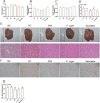Prevotella and succinate treatments altered gut microbiota, increased laying performance, and suppressed hepatic lipid accumulation in laying hens
- PMID: 38369510
- PMCID: PMC10874536
- DOI: 10.1186/s40104-023-00975-5
Prevotella and succinate treatments altered gut microbiota, increased laying performance, and suppressed hepatic lipid accumulation in laying hens
Abstract
Background: This work aimed to investigate the potential benefits of administering Prevotella and its primary metabolite succinate on performance, hepatic lipid accumulation and gut microbiota in laying hens.
Results: One hundred and fifty 58-week-old Hyline Brown laying hens, with laying rate below 80% and plasma triglyceride (TG) exceeding 5 mmol/L, were used in this study. The hens were randomly allocated into 5 groups and subjected to one of the following treatments: fed with a basal diet (negative control, NC), oral gavage of 3 mL/hen saline every other day (positive control, PC), gavage of 3 mL/hen Prevotella melaninogenica (107 CFU/mL, PM) or 3 mL/hen Prevotella copri (107 CFU/mL, P. copri) every other day, and basal diet supplemented with 0.25% sodium succinate (Succinate). The results showed that PM and P. copri treatments significantly improved laying rate compared to the PC (P < 0.05). The amount of lipid droplet was notably decreased by PM, P. copri, and Succinate treatments at week 4 and decreased by P. copri at week 8 (P < 0.05). Correspondingly, the plasma TG level in Succinate group was lower than that of PC (P < 0.05). Hepatic TG content, however, was not significantly influenced at week 4 and 8 (P > 0.05). PM treatment increased (P < 0.05) the mRNA levels of genes PGC-1β and APB-5B at week 4, and ACC and CPT-1 at week 8. The results indicated enhanced antioxidant activities at week 8, as evidenced by reduced hepatic malondialdehyde (MDA) level and improved antioxidant enzymes activities in PM and Succinate groups (P < 0.05). Supplementing with Prevotella or succinate can alter the cecal microbiota. Specifically, the abundance of Prevotella in the Succinate group was significantly higher than that in the other 4 groups at the family and genus levels (P < 0.05).
Conclusions: Oral intake of Prevotella and dietary supplementation of succinate can ameliorate lipid metabolism of laying hens. The beneficial effect of Prevotella is consistent across different species. The finding highlights that succinate, the primary metabolite of Prevotella, represents a more feasible feed additive for alleviating fatty liver in laying hens.
Keywords: Fatty liver; Gut microbiota; Laying hen; Prevotella; Succinate.
© 2024. The Author(s).
Conflict of interest statement
The authors declare that they have no conflicts of interest.
Figures









References
-
- Aziza A, Awadin W, Cherian G. Impact of choline supplementation on hepatic histopathology, phospholipid content, and tocopherol status in layer hens fed flaxseed. J Appl Poultry Res. 2019;28:679–687. doi: 10.3382/japr/pfz019. - DOI
-
- Han GP, Kim DY, Kim K, Kim JH, Kil DY. Effect of dietary concentrations of metabolizable energy and neutral detergent fiber on productive performance, egg quality, fatty liver incidence, and hepatic fatty acid metabolism in aged laying hens. Poult Sci. 2023;102:102497. doi: 10.1016/j.psj.2023.102497. - DOI - PMC - PubMed
Grants and funding
- 32330101/National Natural Science Foundation of China
- 2021YFD1300405/the National Key Research and Development Program of China
- 32102575/the National Natural Science Foundation of China
- CARS-40-K9/Modern Agro-industry Technology Research System
- 2019JZZY020602/the Key Technology Research and Development Program of Shandong province
LinkOut - more resources
Full Text Sources
Molecular Biology Databases
Miscellaneous

